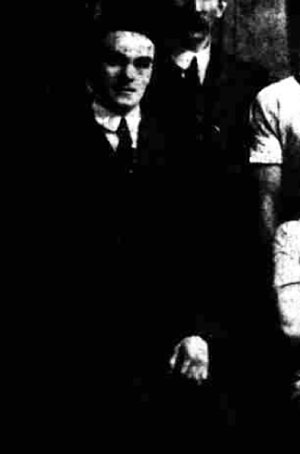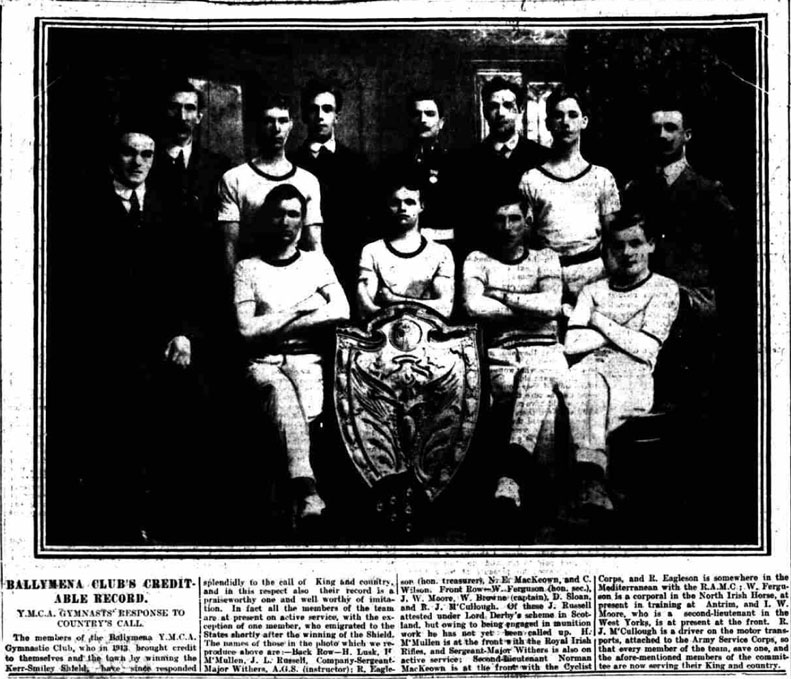Lieutenant William Ferguson

William Ferguson was born on 8 April 1893 at Clonavon Road, Ballymena, County Antrim, the third of three children of coachman (later livery stable proprietor) William Ferguson and his wife Susan (nee McKinney). Educated at Guy's Institute, Ballymena, when the war began he was living with his family at 5 Albert Street and working as a solicitor's clerk for the firm of Alex Caruth & Son.
Ferguson enlisted in the North Irish Horse at Antrim on 8 November 1915 (No.1812). The Ballymena Observer, reporting that he had joined-up, said he was "a well-known vocalist in Ballymena, and was a member of the Y.M.C.A. gymnastic team that won the Kerr-Smiley Shield a few years ago." (See image below.)
Ferguson was promoted to acting lance corporal on 10 December that year, corporal on 7 January 1916 and sergeant on 1 March. On 3 August 1916 he embarked for France, where he was posted to B Squadron of the 2nd North Irish Horse Regiment, joining it in the field at Flesselles a week later.
At the end of August 1916, Ferguson injured a finger while on traffic control duty between Pont Noyelles and Albert. He was hospitalised at Rouen for a month before being discharged to base, rejoining his regiment on 16 December.
On 15 March 1917 Ferguson applied for a commission in the infantry. Two weeks later he left the regiment for training in the UK, reporting for duty after a period of leave at No.14 Officer Cadet Battalion, Berkhampstead, on 7 June.
On 26 September 1917 Ferguson was commissioned as a 2nd lieutenant and posted to the 18th (Reserve) Battalion, Royal Irish Rifles, at Clandeboye. In January 1918 he embarked for France, where he was posted to the 12th Battalion, Royal Irish Rifles, B Company.
The 12th Battalion sustained very heavy casualties during the German offensive from 21 to 28 March 1918. Ferguson was severely wounded and captured during the fighting around Erches on the 26th. According to the battalion war diary:
[23 March] The transport moved to a place near Fretoy and Boileau and Lieut. J. Nelson reported for duty and was [sent] to Major J. Brew. While the transport was proceeding, all O.R's except those in charge of Horses were sent back to form a rear guard party to delay the enemy. All available men were sent under Capt. R.S. Hanson. The party reported to Major J. Brew who was in charge of "details". Capt. R.S. Hanson was recalled and put in charge of Divisional Transport. Night 23/24th. The Transport were in a pontoon across Canal one and a half kilometres from Boileau. During the night 2/Lt G. Foy, W. Ferguson, J.J. McKinney, C.V. Purdon, A.P. Watson reported and were ordered to join Major J. Brew. Lt. J. Nelson was wounded and sent to Hospital, Pioneer Sergeant Cochrane was killed. These were with the details under Major J. Brew defending positions near Flavy-le-Meldeux.
[26 March] 9 A.M. Enemy began to shell village and our troops were falling back. All available men were again collected and sent outside the village to fight a rear-guard action to delay enemy's progress. 5 officers and approximately 60 O.R's were sent forward. Bandsmen were included and the Instruments were dumped at Erches and were not recovered. ...
[27 March] During the fighting around Erches, 2/Lt A.P. Watson was severely wounded and died in Hospital. 2/Lt C.V. Purdon was wounded and admitted to Hospital. 2/Lts G. Foy, W. Ferguson, J.J. McKinney and most of the O.R's are since missing.
Ferguson, whose unit had been attached to the 9th (North Irish Horse) Battalion, Royal Irish Fusiliers at the time, later described the day of his capture as follows:
On the morning of the 26th March '18 the 9th (N.I.H) Battn. Royal Irish Fusiliers were lying at Erches, about 10 kils. N.W. of Roye (having the day previous withdrawn through the French at Guiscard) when they received Orders to immediately make a stand at the Village Andechy about 7 kls. N.W. of Roye. Just before entering the Village we came under heavy Machine Gun fire from the Enemy, but fortunately at this spot there were old French trenches which we immediately occupied. Lively fire was kept up on both sides, and about 2 p.m. the Enemy ventured a few bombing raids down an old Communication Trench. There was some heavy hand to hand fighting, and it was at this time I got wounded. As to how it actually happened I haven't the slightest recollection, but I sustained a fractured skull & other injuries to the head, as well as being shot through the ear. I was knocked unconscious immediately & remained in that condition for several hours, and when I awoke it was to find that I was a Prisoner of War. My Stretcher Bearers informed me afterwards that they carried me to where our Field Dressing Station was in Erches, but on arriving there found that the Village was already in the occupation of the Germans.
Ferguson had sustained a bullet wound to the head. He was held at the Karlsruhe prisoner of war camp in Germany until released on 19 November 1918, returning to England ten days later.
A medical board held on 30 November 1918 found he had "a healed scar and depression of bone in the left frontal region. There is a history of vertigo and headaches but not recently" and that he was not yet fit for active service. It was not until 31 May 1920 that a board found him fully fit.
Ferguson was promoted to lieutenant on 1 March 1919. He relinquished his commission on completion of his service on 12 February 1921.

Ballymena Weekly Telegraph, 4 March 1916
